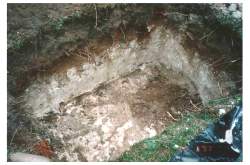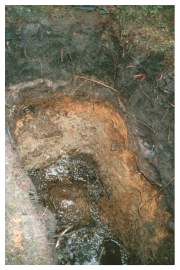 Forest and woodland soils vary widely in their physical, chemical and hydrological properties and the implications of each are significant to archaeological preservation. However, it is possible to make some very generalized comments about the burial environment within each major group of forest soil.
Forest and woodland soils vary widely in their physical, chemical and hydrological properties and the implications of each are significant to archaeological preservation. However, it is possible to make some very generalized comments about the burial environment within each major group of forest soil.
Brown earths
Typically deep, well-drained soils with good aeration and is therefore unlikely to preserve organic material. The soil pH may range from acidic to alkaline this may be the biggest preservation determining factor. These soils may also be well mixed by bioturbation.
Podzols and ironpans
 Typically acidic, but with variable hydrological properties. Organic material may be preserved where waterlogging occurs, but archaeological evidence susceptible to acidic dissolution such as bone may be lost.
Typically acidic, but with variable hydrological properties. Organic material may be preserved where waterlogging occurs, but archaeological evidence susceptible to acidic dissolution such as bone may be lost.
Gley soils
Characterised by their seasonal or permanent waterlogging and in the latter case, are more likely to preserve organic archaeological and palaeoenvironmental remains. The pH may be variable and will determine what types of archaeological materials are likely to persist.
Rankers and Rendzinas
These are both shallow soils, where any buried archaeological evidence is likely to have been subjected to bioturbation. Rendzinas occur over chalk and tend to be neutral to alkaline in pH. These may favor the preservation of remains such as bone and molluscs. Rankers are more variable in pH. Both soil types tend to be well-drained.
Peaty soils
These are often of an acidic pH with a high organic content. Where they remain waterlogged, they are well known for their ability to preserve many types of organic material including pollen grains, wood, leather and skin. Deep peat soils can also accumulate over a relatively short time period and many archaeological features have been rediscovered, buried below a blanket of peat. Any drainage will result in a loss of any waterlogged environment and possible peat shrinkage.